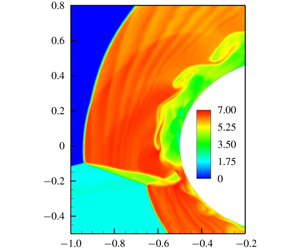Article contents
A study of longitudinal processes and interactions in compressible viscous flows
Published online by Cambridge University Press: 23 April 2020
Abstract

Fluid motion has two well-known fundamental processes: the vector transverse process characterized by vorticity, and the scalar longitudinal process consisting of a sound mode and an entropy mode, characterized by dilatation and thermodynamic variables. The existing theories for the sound mode involve the multi-variable issue and its associated difficulty of source identification. In this paper, we define the source of sound inside the fluid by the objective causality inherent in dynamic equations relevant to a longitudinal process, which naturally favours the material time-rate operator  $D/Dt$ rather than the local time-rate operator
$D/Dt$ rather than the local time-rate operator  $\unicode[STIX]{x2202}/\unicode[STIX]{x2202}t$, and describes the sound mode by inhomogeneous advective wave equations. The sources of sound physical production inside the fluid are then examined at two levels. For the conventional formulation in terms of thermodynamic variables at the first level, we show that the universal kinematic source can be condensed to a scalar invariant of the surface deformation tensor. Further, in the formulation in terms of dilatation at the second level, we find that the sound mode in viscous and heat-conducting flow has sources from rich nonlinear couplings of vorticity, entropy and surface deformation, which cannot be disclosed at the first level. Preliminary numerical demonstration of the theoretical findings is made for two typical compressible flows, i.e. the interaction of two corotating Gaussian vortices and the unsteady type IV shock/shock interaction. The results obtained in this study provide a new theoretical basis for, and physical insight into, understanding various nonlinear longitudinal processes and the interactions therein.
$\unicode[STIX]{x2202}/\unicode[STIX]{x2202}t$, and describes the sound mode by inhomogeneous advective wave equations. The sources of sound physical production inside the fluid are then examined at two levels. For the conventional formulation in terms of thermodynamic variables at the first level, we show that the universal kinematic source can be condensed to a scalar invariant of the surface deformation tensor. Further, in the formulation in terms of dilatation at the second level, we find that the sound mode in viscous and heat-conducting flow has sources from rich nonlinear couplings of vorticity, entropy and surface deformation, which cannot be disclosed at the first level. Preliminary numerical demonstration of the theoretical findings is made for two typical compressible flows, i.e. the interaction of two corotating Gaussian vortices and the unsteady type IV shock/shock interaction. The results obtained in this study provide a new theoretical basis for, and physical insight into, understanding various nonlinear longitudinal processes and the interactions therein.
- Type
- JFM Papers
- Information
- Copyright
- © The Author(s), 2020. Published by Cambridge University Press
References
- 17
- Cited by


